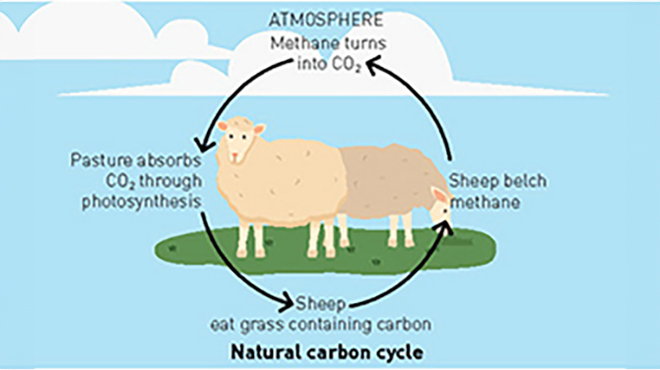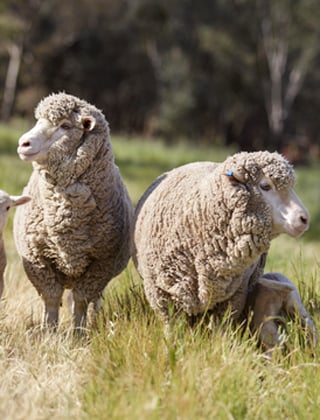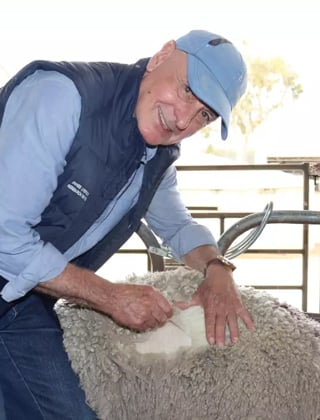Australian wool production is in the box seat to help livestock industries become part of the climate solution

Wouldn’t it be great if we could market our wool as being the most sustainable in Australia and get a premium for this?
Australian wool production is moving towards carbon neutrality as outlined in Australian wool industry’s 10-year Wool 2030 Strategy, and in the Australian sheep and wool industry’s Sheep Sustainability Framework, This means that the industry is working towards making no net release of greenhouse gas (GHG) emissions into the atmosphere. Key drivers to help achieve this will be: research into and adoption of strategies to reduce and mitigate methane emissions; further promotion of the positive role that wool production plays in improving the sustainability of Australian Agriculture; plus of course continued emphasis of wool being the environmentally sustainable fibre choice for textiles.
Around 15% of the world's entire total GHG emissions come from livestock production - sheep, cattle and other ruminants. Methane, primarily from burps, is a GHG 28 times more powerful than carbon dioxide (Source: CSIRO). In Australia, direct livestock emissions account for about 70% of GHG emissions by the agricultural sector and 11% of total national GHG emissions. This makes Australia’s livestock the third largest source of GHG emissions after the energy and transport sectors. Livestock are the dominant source of methane and nitrous oxide, accounting for 56% and 73%, respectively, of Australia’s emissions (Source: Dept Ag and Food).
The good news for Australian woolgrowers is that by running our sheep even more sustainably, this has the potential to help our industry become part of the climate solution, instead of being partly blamed for being the problem. This is because the negative effects from methane are relatively short-lived, as methane is eventually oxidised back to water and CO2 in around 12 years as part of the natural biogenic carbon cycle. The CO2 and water then get taken up by the grass that the livestock consume to continue a closed cycle. So if we don't increase the number of ruminants on the planet, and the amount of methane they emit, then ruminants will have no net effect on global warming. Whereas, CO2 from burning fossil fuels stays in the atmosphere for potentially 1000’s of years. Therefore, reducing methane emissions has the potential to improve environmental sustainability thus helping the wool industry become part of the climate solution. By reducing methane emissions from sheep, we are actively pulling carbon out of the atmosphere which induces global cooling. So if Australian woolgrowers can decrease methane emissions, then exciting things can happen.
Given all of these facts flying around, it is no surprise that there is so much noise in this space. Now that we are across the facts, and no matter where you sit in this debate, let’s focus on the positive role that Australian wool production can play in becoming part of the climate solution, and how to make this happen.
Woven with Sustainability
Wool has long been accepted as an environmentally positive fibre choice with a number of benefits, such as being 100% natural, renewable, biodegradable and recyclable. Not to mention that it is thermo-regulating, easy to care for, and can be repaired and enjoyed for years and years. Wool is therefore well placed to take advantage of the growing shift towards planet-friendly products. Currently cotton and synthetic fibres are the most widely used and produced fibres globally, and yet they do not share the same performance, repairability and environmental credentials as wool. This fact continues to be promoted in the The Woolmark Company’s ‘Wear Wool, Not Fossil Fuel’ marketing campaign. However, to optimise the eco-credentials of Australian wool and ensure that it is regarded as a sustainable fibre by all, AWI is also devoting resources to remedy any environmental weak spots in the wool supply chain.
Methane mitigation strategies for lower emission wool production
Numerous pathways are currently being investigated by AWI for woolgrowers to reduce emissions. These potential GHG mitigation strategies include:
- the use of feed additives (e.g., asparagopsis seaweed);
- nutritional management practices (e.g., increased feed quality) or low methane pasture species;
- genetic selection for reduced emissions and improved livestock feed efficiency;
- increasing flock productivity (producing more lambs and wool from each sheep); and
- offset emissions by increasing on-farm carbon sequestration and storage, such as through improved management of soil organic matter and tree planting.
The race is on to see which of these mitigation strategies will be crowned the winner to support livestock industries, reduce methane emissions, and become part of the climate solution.
The use of additives in particular has received a huge amount of interest and investment. However, a number of questions remain unanswered as to which approach is the best one. For feed additives, there are concerns around: how much they cost and who will bear the brunt of the costs for these additives?; are there any side effects?; what are consumer perceptions of their use?; do they actually work at scale in both grass-based and intensive production systems?; and, how long are they effective for? On the flipside, the strategy of genetic selection for reduced emissions has been flagged as potentially being the most favourable strategy, due to the changes being more permanent, cost-effective and cumulative. After all, genetics and breeding improvements are already a trusted and proven technology for woolgrowers to increase production efficiency and profitability.
Significant research is underway to assess and identify the technical feasibility, the cost-benefits, and the risks and barriers to achieving lower-emission wool using the above approaches.
AWI is actively collaborating with other rural Research & Development Corporations (RDCs) on several GHG-related projects. While this focus on carbon neutrality and reducing GHG emissions is primarily aimed at reducing the environmental footprint of the Australian wool industry, it also seeks to open up avenues for woolgrowers, who are taking steps to reduce their farm's carbon footprint, to receive a premium by selling their ‘carbon neutral’ wool to brands or earning income from carbon mitigation as an ‘ecosystem service’.

What does this all mean to woolgrowers today?
The noise around carbon, methane and sustainability is not going away. Western Australian woolgrowers are the most innovative in the world, so let’s remain proactive on this issue and address it head on. Wouldn’t it be great if we could market our wool as being the most sustainable in Australia and get a premium for this?
Given Australian wool is already the sustainable fibre choice, plus wool production actively pulls carbon out of the atmosphere as part of the natural carbon cycle, it is clear that woolgrowers are in the box seat to help Australian Agriculture become part of the climate solution. So as woolgrowers, let's not get caught up on this issue, instead let's focus on the positive role that the wool industry can play in being part of the climate solution. Let’s proactively engage in conversations on the sustainability of wool production and continue to follow and improve the sustainability of our farms to take full advantage of this opportunity.
For more information visit www.wool.com/sustainability
Georgia Pugh, AWI Extension WA








